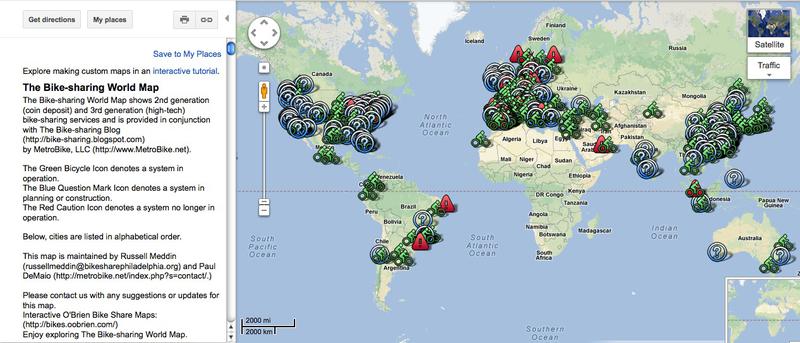Though I’ve used bike-sharing programs in three different countries (Spain, America and Canada), it wasn’t until I saw a news story about a bike-sharing program in Dubai that I started to wonder just how international the trend had become. Luckily, the researchers over at the bike-sharing consultancy Metrobike (which also runs the helpful, if generically named Bike-sharing Blog) have collected this data and put it into an easy to use Google map, called The Bike-Sharing World Map.
The map shows the location of functioning programs, proposed programs and ended or failed programs all around the world. The map has a lot of surprises: not only how far bike sharing has spread: from Auckland, New Zealand to Bandung, Indonesia to Baku, Azerbaijan, but also the vast number of Chinese bike-sharing programs. We hear very often about the rise of traffic, of cars and non-sustainable transportation cultures in China, but there are nearly fifty bike sharing programs in China. And many of these fleets are huge: some Chinese cities' systems have over fifty thousands bikes and get millions of riders a year! Indeed, there are almost three times as many Chinese bike-sharing programs as there are American ones.
Another major takeaway from the image is just how far the US, Canada and the UK are behind Europe and Japan when it comes to bike-sharing. A quick glance at the full world map reveals a tremendous density of bike-sharing programs in Western Europe: Spain, Northern Italy, and especially Switzerland have a high density and number of bike-sharing programs. Japan also has a large number of the programs. England has a particularly ignominious record, with failed bike shares outnumbering existing ones.
This year, we’ve seen Mutual Aid in Motion.
From scaling sharing hubs to Mutual Aid 101 trainings, we’re helping communities build the tools they need.
Every dollar fuels lasting resilience – proving that when we move together, we all move forward.
The map also shows that the US has many more proposed bike-sharing programs than successful ones: the question mark symbol (which indicates a proposed bike-share on the Bike-Sharing World Map) predominates in the US. As with most issues of sustainable public transportation options, the US is years behind Western Europe and Japan.
The map, in other ways, mostly reflects trends of wealth. The only bike-share in all of Africa is on the Canary Islands (technically part of Spain), there are none in Central America or Central Asia, and fewer in Eastern Europe and South America (though Brazil has a good number) than elsewhere. Of course, these trends probably reflect growth and development of urban wealth more than questions of commitment to sustainability or public transportation
Each item on the map can be selected, and the map will tell you the size of the fleet, the date of the program’s start, give you a link to the program’s website, and indicate other relevant information (including the vendor, the operation style, and more.) For learning about bike-sharing either in depth or at a glance, the Bike-Sharing World Map is a tremendous resource.

